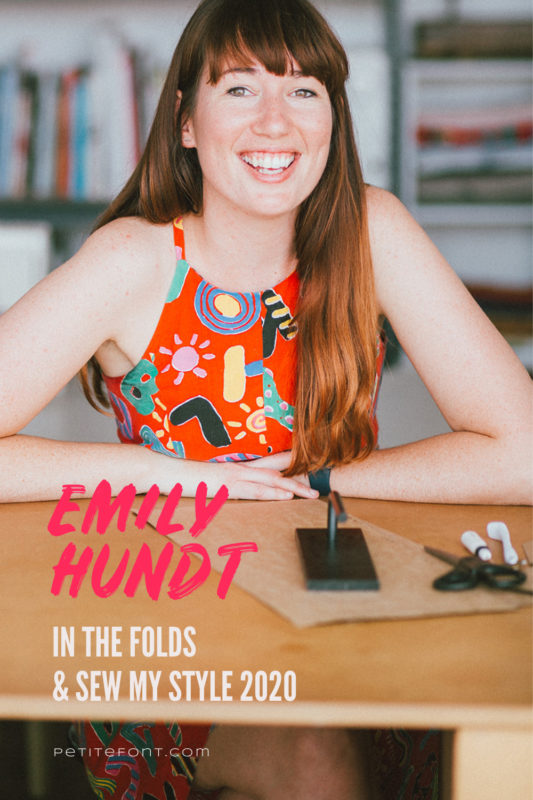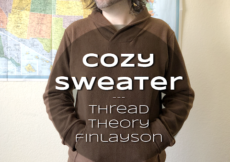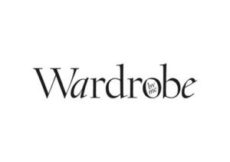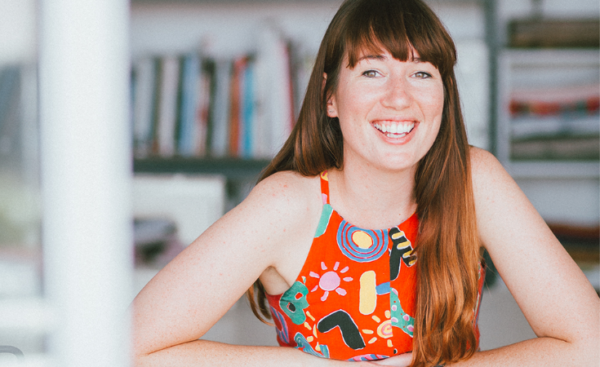
I was so excited when Emily from In the Folds agreed to launch her new Barkly Skirt with Sew My Style this year.
As an Australian designer with inclusive sizing, Emily was a rare find. As a team, we wanted to work with as many international designers as possible. In the Folds fit the bill!
Of course, releasing a new pattern in the middle of the year meant we were again sworn to secrecy about it. And what a pattern! The paneled skirt comes with 8 variations.
The #SMS20 team is grateful for Emily’s contribution. Here we’ll learn more about her and In the Folds.
What is your name? Emily Hundt
What is your company’s name and how did you come up with it? The name of my company is In the Folds. It took me a long time to come up with a name! When I started out, I knew I wanted to create sewing patterns, but I didn’t know what else I would like to do further down the track, so I didn’t want to choose a name that would box me in to one particular thing. I went back and forth with so many ideas, but eventually realised I needed something that related to my vision for the brand.
I knew that I’d begun to really find my voice as a designer when I was in my final year of university, so I dug out my graduate collection portfolio and flicked through the pages. It started with a line that felt like it summed up my work at the time, and continues to today, ‘In the folds there are stories.’ I have always been interested in how we use clothing to define ourselves and the meaning and stories these garments carry with them – a gift from a friend, a piece handed down from mother to daughter, a piece made with love and care. It epitomises my work is about and what I hope it represents to those that use my patterns.
How long has your company existed? I started In the Folds in 2015.
When did you decide to become a pattern designer? That’s a tricky question! I can’t remember making the decision – it just seemed to be a decision that was made gradually sometime during my four years at university.
I decided to study fashion design as I thought I’d like to be a costume designer, but within a year or so I realised that I was very much drawn to the patternmaking and construction sides of things. There is something very satisfying about taking something two dimensional and making it into a three dimensional garment that feels like it lives and breathes. By the time I graduated, I had worked hard on honing my patternmaking skills and had decided that I would work towards a career as a patternmaker.
What inspired you to start creating patterns? After finishing university, I took off to London (from my home in Sydney) to gain experience in the fashion industry. I did two internships – one focusing on patternmaking and the other with an online style-sharing community hub, The Good Wardrobe. I had my heart set on patternmaking, but I also knew I wanted to become more educated about the ethical and environmental impacts of the fashion industry – so the two internships felt like a good balance.
While working with Zoe, the founder of The Good Wardrobe, she showed me an interview she had done with Tilly Walnes of Tilly and the Buttons, and my mind was blown. I had somehow been sewing my whole life and never stumbled upon the online sewing community. I instantly became obsessed with all things online sewing and began consuming blogs constantly—learning more and more about how people were using online resources to learn to sew and how independent companies were disrupting the sewing industry.
University had really taken a toll on me and since finishing I had barely wanted to go near a needle and thread. Suddenly I felt inspired to make again. I bought a lovely second hand sewing machine and some basic patternmaking equipment (I didn’t want to go overboard with equipment as I only had a 2 year visa to be in the United Kingdom). Without a dress form, it brought me back to basics and flat patternmaking (rather than draping on a dress form) and I started drafting clothes for myself – experimenting with shape and form.
Two of these early garments were to become my two first patterns, The Rushcutter and the Acton dress (although I didn’t know it then). When it was time to head home, a seed had been firmly planted in my head, and it felt like a great time to start a business. Six months later, I released my first pattern and that’s what I’ve been doing ever since.
What background do you have in pattern design (self-taught, technical schooling, etc)? I have a Bachelor of Design in Fashion and Textiles from the University of Technology in Sydney. At university, we learned everything from the principles of design, through to pattern making, construction, and using design software – such as Adobe Illustrator and Indesign – which has proved very handy in my career producing patterns.
Are you #teamcut or #teamtrace? It depends… If I’m using a printed pattern then I’m Team Trace. One thing I have learned from sewing for so long is that bodies change. As my style is fairly classic and I steer clear of on-trend pieces when possible, I hope that I will be going back to the patterns in my collection for years to come – with this in mind, I trace so I can always go back to the full pattern when I need to.
But when it comes to PDF patterns – which I use a lot, due to the instant gratification factor and the ability to print in copyshop format quite close to my house/studio – I’m Team Cut. I like printing just my size (which you can do with most PDF patterns) and cutting it straight out.
Is your sewing space messy? Can we see a picture? I move between my studio, where I have my workspace set up and work the majority of the time, and my home where I have a small sewing table set up.
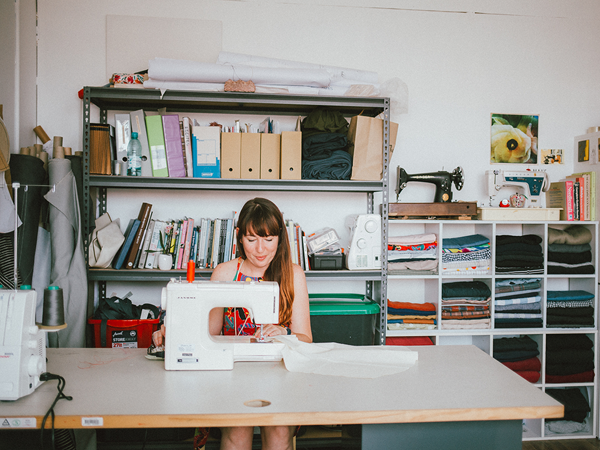
A couple of years ago I realised that I would never get the opportunity to sew for myself if my sewing machines were at work, so it was time to make a little space at home. Although I definitely don’t sew for myself as much as I would like, it has helped. It also made me admit that being a sewing pattern designer involves about 80% computer work, 10% hands-on patternmaking and 10% sewing. I like batching all the sample and toile sewing when I can so that every so often I can spend a day working from home – which means sewing in my pajamas with a good podcast on.
How would you describe the person you envision making your pieces? The person using In the Folds patterns is drawn to pieces that make them feel comfortable and at ease to do all the things they want to do. They’re not looking for on-trend pieces, but garments that will last the test of time, in both quality and design—with some interesting design details sprinkled in.
They are looking for a project that cannot be made in an hour or two, but one that they can sink their teeth into and work on over a few days or even weeks. They are looking to make pieces that are as beautiful on the inside as they are on the outside and are hoping to learn new skills with each new piece they make. They are thoughtful and considered in the garments they sew, and they are hoping to make garments that they will want to wear, love and cherish long into the future.
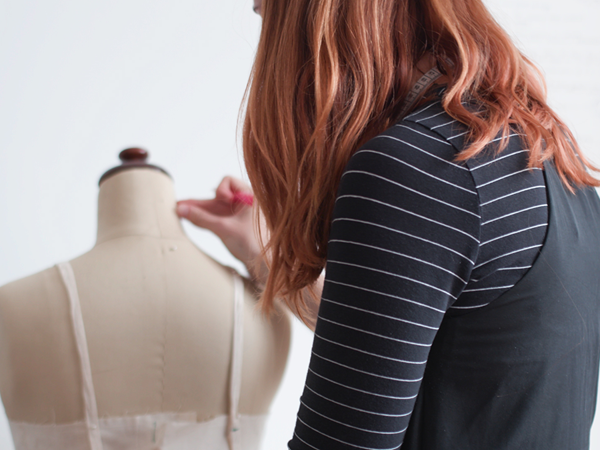
Where do you get ideas for new designs? It is a mixture between thinking about garments that I would like to wear myself, as well as seeing gaps in my current collection and designing pieces to fill those gaps. As my focus is on creating pieces that will last the test of time, it makes sense for me to design pieces that work well worn together.
The Collins top came from a desire to make a pattern that was more beginner-friendly than my other offerings, while the Barkly skirt was designed to be another option to wear on the bottom, that would work with the other pieces in the collection.
Once I have an idea of the type of garment I would like to design, I just start patternmaking. I’m not a great drawer and find it difficult to translate my ideas into a drawing. My preference is to just start with the basic idea and make a pattern. I then make a toile and see how it looks and feels, make adjustments, and then make another one.
And another one.
And another one.
This method works very well for me and underpins what I think makes my designs interesting and unique—but it does take a lot more time than if I just had an idea, drew it up, and made a pattern. Sometimes I’ll make 15 toiles before I have even finalised the design.
This method also works well as I am able to try many different construction techniques and find the best way to do a particular thing. When creating sewing patterns it’s not just about making a design that looks good – it’s about making a pattern that works well, has thoughtful finishing techniques that make sense for the application and teaches the maker new skills. So all that is to say, there are a lot of moving parts at play when I’m considering new designs!
What has been your all time most challenging sewing project? Jeans for sure. They weren’t necessarily difficult to sew, but getting the fit just right took some time and a lot of patience. Just when I thought I’d got them right, I realised they sat a bit too high for my comfort levels, and I realised that this was going to be the difference between a pair of jeans that I reached for over and over and a pair of jeans that remained in the wardrobe.
So I took a couple of days off, took some long deep breaths and removed the waistband and the fly (and a lot of topstitching) and started that bit again. It definitely paid off though, I wear the jeans constantly and plan to make another pair now that I’ve got the fit just right.
When was the last time you sewed something for yourself and what was it? Is it terrible that I can’t remember? When I was dreaming of starting a pattern company, I envisaged myself sewing all the time and having a jam-packed me-made wardrobe.
The reality is not quite like that unfortunately, but I do feel very lucky to be able to spend my time making sewing patterns so that all of my lovely customers can fill their wardrobes with gorgeous me-made garments. It feels like a small sacrifice in the scheme of things.
Next up? Definitely those jeans I mentioned—I have some black denim washed and ready to go!
What do you hope people gain from using your patterns? I hope that makers gain a sense of confidence from using my patterns. I hope they finish up feeling like they have learned new things, have some new techniques under their belt and a garment that they love to wear. I hope they gain an appreciation for the amazing things they can do with their hands and a feeling that it’s worth slowing down to make a garment that really ticks all the boxes.
What inspires you? Thinking about the people I make patterns for really inspires me. Knowing that there are real living people out there using my products to make things they love to wear never gets old. I absolutely love receiving emails from my customers telling me what they enjoyed or learned from my patterns, and that fires me up to keep working away at growing my little business.
What also inspires me is thinking about the skills I want to teach others. I know how satisfying it can be to learn a new technique or finishing a seam in the most beautiful way, and knowing that I can share that feeling with others is what continually inspires me to design another pattern.
Thank you, Emily!
To learn even more about Emily and In the Folds, check out her website.
Click here to read all the Sew My Style Designer Q&As.
New to Sew My Style? Learn more and join in here.
Sew My Style 2020 includes these talented sewists, catch up on their #SMS20 posts:
Aaronica @ The Needle & The Bell | Ari @ Max California | Minna @ The Shapes of Fabric | Carol @ Chatterstitch | Michele @ WinMichele | Julian @ Julian Creates | Florence @ FTMom3 | Kelsey @ Seam Lined Living | Kris @ Sew Notes | Laura @ The Specky Seamstress | Sarah @ Haraz Handmade | Shelby @ Handmade Shelby | and SMS20 Coordinator Paulette @ Petite Font
To stay up-to-date with all the #SMS20 news, pattern discounts and inspiration, be sure to subscribe to the newsletter at Sew My Style 2020.
Pin this to read later:
